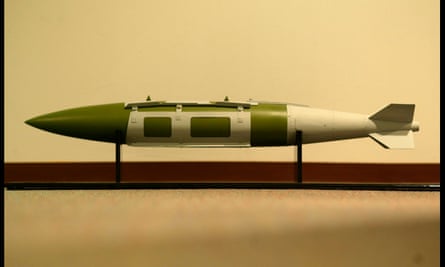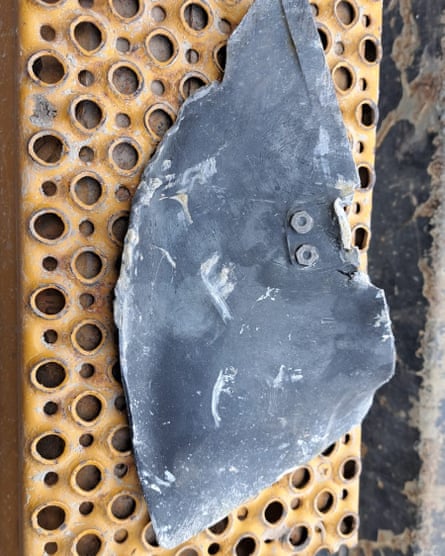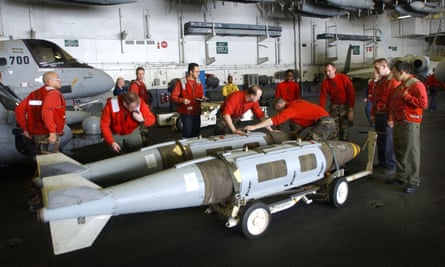A Guardian investigation has found that Israel used a US munition to target and kill three journalists and wound three more in a 25 October attack in south Lebanon which legal experts have called a potential war crime.
On 25 October at 3.19am, an Israeli jet shot two bombs at a chalet hosting three journalists – cameraman Ghassan Najjar and technician Mohammad Reda from pro-Hezbollah outlet al-Mayadeen, as well as cameraman Wissam Qassem from the Hezbollah-affiliated outlet al-Manar.
All three were killed in their sleep in the attack which also wounded three other journalists from different outlets staying nearby. There was no fighting in the area before or at the time of the strike.
The Guardian visited the site, interviewed the owner of the property and journalists present at the time of the attack, analysed shrapnel found at the strike site, and geo-located Israeli surveillance equipment in range of the journalists’ positions. Based on the Guardian’s findings, three experts in international humanitarian law said the attack could constitute a war crime and called for further investigation.

“All the indications show that this would have been a deliberate targeting of journalists: a war crime. This was clearly delineated as a place where journalists were staying,” said Nadim Houry, a human rights lawyer and executive director of the Arab Reform Initiative.
After the strike, the Israeli military said that it had struck a “Hezbollah military structure” while “terrorists were located inside the structure”. A few hours after the attack, the Israeli army said that the incident was “under review” following reports that journalists were hit in the strike.
The Guardian found no evidence of the presence of Hezbollah military infrastructure at the site of Israel’s attack, nor that any of the journalists were anything but civilians. The Israeli military did not respond to a request for clarification of which of the journalists were Hezbollah militants nor on the status of the strike’s review.
“Ghassan was not a member of Hezbollah, he was a member of the press. He never had a gun, not even for hunting. His weapon was his camera,” Sana Najjar, Ghassan Najjar’s wife, said in an interview with the Guardian. Ghassan left behind a three-and-a-half-year-old son.
The coffin of one of the journalists, Qassem from al-Manar, was buried wrapped in a Hezbollah flag. The practice is an honorific for people or families who profess political support for the group, but does not indicate that the journalist occupied a political or military role in Hezbollah.
Regardless of their political affiliation, killing journalists is illegal under international humanitarian law unless they are actively participating in military activities.
Janina Dill, co-director of the Oxford Institute for Ethics, Law and Armed Conflict, said: “It is a dangerous trend already witnessed in Gaza that journalists are linked to military operations in virtue of their assumed affiliation or political leanings, then seemingly become targets of attack. This is not compatible with international law.”

A day after Israel began its ground offensives inside Lebanon, a group of about 18 journalists arrived at a luxury guest house resort in Hasbaya, south Lebanon in October. The Israeli advance had forced them to relocate from Ebl al-Saqi, a town in south Lebanon where they had stayed for the past 11 months to cover the hostilities between Hezbollah and Israel.
They chose to stay in the Druze-majority town due to its lack of affiliation with Hezbollah and because it had not previously been targeted by Israeli strikes, according to Yumna Fawaz, a journalist for Lebanese outlet MTV who was present on the day of the attack.
The guest houses were owned by a Lebanese-American, Anoir Ghaida, who said that he searched the chalet and car of the targeted journalists after the strike “like you would search for a needle in a haystack,” but found “nothing suspicious” about the journalists.
The reporters used the guest houses as a base for 23 days, travelling to a hilltop a 10-minute drive away to film hostilities and produce live coverage each day. The hilltop gave a view of the border villages of Chebaa and Khiam, where fighting between Hezbollah and Israel continued. They drove cars marked with “Press”, and wore flak jackets and helmets emblazoned with press symbols.
The hilltop was in direct line of sight of three Israeli watchtowers – all within approximately 10km from the live location. Israeli watchtowers are commonly equipped with “Speed-er” cameras, which can automatically track targets up to 10km away, as well as video, thermal and infrared imaging capabilities.
Other journalists in the group said that the presence of Israeli reconnaissance drones was “constant” over both the live location and the Hasbaya guest house during their 23-day stay there.
“On the night of the attack, we were sitting in front of the chalets and the drone was flying super low on top of us,” said Fatima Ftouni, a journalist at al-Mayadeen who was staying a few chalets down from her colleagues when they were struck.
Ftouni went to bed but was awakened a few hours later by the sound of an explosion. She dug herself out from beneath the rubble of her chalet’s collapsed roof and reached for her helmet. Her flak jacket had been shredded by the force of the blast. She escaped her smoke-filled room to find her colleagues dead on the ground.
The chalet where Najjar, Reda and Qassem had been sleeping had been directly struck by a bomb delivered by an Israeli jet, with another bomb landing beside the structure.

Remnants of munitions found at the site revealed that at least one of the weapons was a 500lb MK-80 series bomb guided by a US-made JDAM – a kit that converts large dumb bombs into precision-guided weapons. The fragments were verified by Trevor Ball, a former bomb disposal specialist for the US army, a second arms expert at Omega Research Foundation and a third weapons expert who was not authorised to speak to the media.
A piece of the tail fin of the Jdam, produced by Boeing, as well as part of the internal control section that moves the fin, was found. A cage code on the remnant of the control section revealed that it was produced by Woodward, a Colorado-based aerospace company. Neither Boeing nor Woodward responded to requests for comment.
The use of at least one precision-guided bomb would imply that the Israeli military selected the chalet housing the three journalists as a target before the strike. The presence of drones and watchtowers overlooking the group of clearly marked journalists for the prior 23 days makes it likely that Israeli forces were aware of their location – and their status as members of the press.
A state department spokesperson declined to comment on the attack in Hasbaya but said that the US has “consistently urged Israel to ensure protection of civilians, including journalists”.
Under US law, if a country uses arms supplied by the US in a war crime, military assistance to that country should be suspended. Despite evidence of several instances where US munitions have been used by Israel to commit potential war crimes, US military assistance to Israel has continued unaffected.

Israel has killed six journalists in Lebanon and at least 122 in Gaza and the West Bank since 7 October 2023 – the deadliest period for journalists in the last four decades, according to the Committee to Protect Journalists.
According to Irene Khan, the UN special rapporteur on the promotion and protection of the right to freedom of opinion and expression, Israeli authorities are “blatantly ignoring” its international legal obligations towards the protection of journalists.
Khan said: “The Guardian’s story of what happened in southern Lebanon matches with the pattern of killings and attacks by Israeli forces on journalists in Gaza. Targeted killings, the excuse that the attacks were aimed against armed groups without providing any evidence to support the claim, the failure to conduct thorough investigations, all seem to be part of a deliberate strategy by the Israeli military to silence critical reporting on the war and obstruct the documentation of possible international war crimes.”
Despite statements indicating that it would review certain attacks against journalists, the Israeli military has yet to release any information regarding investigations into its killing of journalists.
“It is the silence of the international community that let this happen,” Ftouni said.

Attacks on journalists in Hasbaya and other parts of south Lebanon have had a chilling effect on media workers in Lebanon, who no longer know where they can work safely.
Meanwhile, the families of the journalists are unable to move past the loss of their loved ones.
“He really was a great man. I know he looked so big, but he was really a gentle man. And he was so, so funny,” Najjar said of her husband, Ghassan.
“I still don’t believe that Ghassan died. I’m still waiting for the door to open and for him to enter. He promised me that someday we would grow old and we would go live in the south together – but now he stayed there and I will stay here, in Beirut, forever,” she said.






